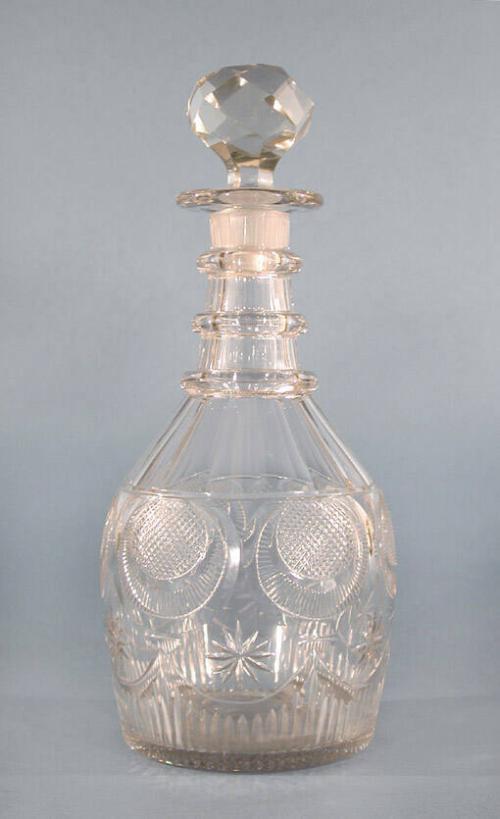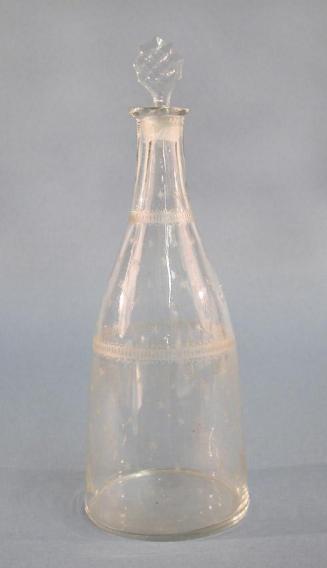Decanters with Stoppers
Original OwnerPossibly originally owned by
George Dodd
MakerMade by
Unknown
Date1815-1830
MediumBlown and cut colorless lead glass with a light grey tint
DimensionsComponent (height including stopper x diameter of .15a,b): 10 1/2 x 4 1/2in. (26.7 x 11.4cm)
Component (height including stopper x diameter of .16a,b): 11 x 4 1/2in. (27.9 x 11.4cm)
ClassificationsGlassware
Credit LineGift of Mary F. Lord and Katherine L. Lord
Object number1938.24.15a,b-16a,b
DescriptionPair of decanters with stoppers made of blown and cut colorless lead glass with a light grey tint. Each decanter (.a) has a flared lip, an inverted cylindrical neck, a sloping shoulder, a semi-barrel shaped body, and a flat bottom with a polished pontil mark. Each decanter has three thick applied rings around the neck, and wide, cut flutes above, between, and below the rings on the shoulders. Below the flutes, on the body of each decanter, are six round cut designs. Each design consists of a smaller circle with a field of diamonds inside. This is off-center inside a larger circle, with a row of short rays pointing toward the larger circle inside. Below and between each design are cut, twelve-pointed stars and a scalloped line. Short flutes extend from the scalloped line to the bottom edge of each decanter. The interior of the neck of each decanter was ground to receive a stopper.
Each decanter is accompanied by a different stopper. Stopper .15b is made of colorless glass with a light yellow tint; there is a polished area on top of the stopper. Stopper .15b consists of a solid, round, faceted finial above a ground tapered portion that fits into the neck of the decanter. Stopper .16b is made of colorless glass, but with a light green tint. Stopper .16b consists of a pressed, flat, disc-shaped finial with an impressed circle in the center above a ground tapered portion that fits into the neck of the decanter. A jagged crack cuts across the disc-shaped finial of the stopper.
From a distance, the decanters appear to be a different color. This is because one decanter (.16a) has dirt adhered to the cracks and crevaces in the cut decoration. Both decanters and stopper .15b have small chips and nicks on some cut edges. Each decanter has a ring of light scratches and wear around the bottom edge.
Pontil mark: A rough place on a blown glass object where the solid metal rod, or pontil, is cracked off the object after final shaping and decoration. Pontil marks can be polished to achieve a smooth surface.
Each decanter is accompanied by a different stopper. Stopper .15b is made of colorless glass with a light yellow tint; there is a polished area on top of the stopper. Stopper .15b consists of a solid, round, faceted finial above a ground tapered portion that fits into the neck of the decanter. Stopper .16b is made of colorless glass, but with a light green tint. Stopper .16b consists of a pressed, flat, disc-shaped finial with an impressed circle in the center above a ground tapered portion that fits into the neck of the decanter. A jagged crack cuts across the disc-shaped finial of the stopper.
From a distance, the decanters appear to be a different color. This is because one decanter (.16a) has dirt adhered to the cracks and crevaces in the cut decoration. Both decanters and stopper .15b have small chips and nicks on some cut edges. Each decanter has a ring of light scratches and wear around the bottom edge.
Pontil mark: A rough place on a blown glass object where the solid metal rod, or pontil, is cracked off the object after final shaping and decoration. Pontil marks can be polished to achieve a smooth surface.
Status
Not on view














